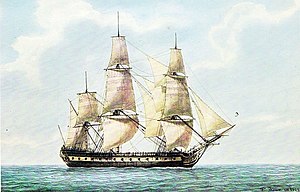Bordelois was a 56-gun ship of the line of the French Navy, lead ship of her class. She was funded by a don des vaisseaux donation from the city of Bordeaux, and built by engineer Léon Guignace on a design by Antoine Groignard.[1] Complete too late to serve in the Seven Years' War, she was razéed into a frigate and used as an East Indiaman. She was rebuilt into a frigate to serve in the War of American Independence. Captured by HMS Romney, she was brought into British service as HMS Artois.

| |
| History | |
|---|---|
| Name | Bordelois[notes 1] |
| Namesake | City of Bordeaux |
| Builder | Bordeaux[1] |
| Laid down | January 1762[1] |
| Launched | 26 April 1763[1] |
| In service | July 1763[1] |
| Out of service | 19 June 1779[1] |
| Renamed | États d'Artois in 1779 |
| Captured | by HMS Romney on 1 July 1780 |
| Notes |
|
| Name | HMS Artois |
| Acquired | captured by HMS Romney on 1 July 1780 |
| Fate | Sold February 1786 |
| General characteristics | |
| Displacement | 1,100 tonnes[1] |
| Length | 50.7 m (166 ft 4 in)[1] |
| Beam | 13.8 m (45 ft 3 in)[1] |
| Draught | 6.3 m (20 ft 8 in)[1] |
| Propulsion | Sail, full-rigged ship |
| Armament |
|
Career edit
Bordelois was commissioned in July 1763 under Captain Charles de Cornick-Duchène, arriving in Rochefort on 6 September after the end of the Seven Years' War.[1][2] In 1768, she was razéed to a large frigate, while her spare timber was used to rebuild Ferme.[1]
From 1776 to 1778, Bordelois was used as an East Indiaman, after which she became a hulk in Lorient.[1]
In 1779, on the background of the Franco-American alliance, Bordelois was sold and razéed into a 40-gun frigate; her refitting having been financed by the States of Artois, she was renamed to États d'Artois . She entered drydock in June 1779, to be launched in January 1780 and commissioned in May 1780.[1]
On 1 July 1780 Artois was captured by HMS Romney, and brought into British service as HMS Artois.[1]
She participated in the Battle of Dogger Bank. "Artois was the finest frigate then known; had 28 18-pounders on her main deck with in addition to her complement of guns, heavy carronades on the quarterdeck and forecastle; Manned by 300 men".[3]: 47
Notes edit
- ^ "Bordelois" is an ancient graphy of "Bordelais"
References edit
- ^ a b c d e f g h i j k l m n o p Roche, Jean-Michel (2005). Dictionnaire des bâtiments de la flotte de guerre française de Colbert à nos jours, 1671 - 1870. Group Retozel-Maury Millau. p. 79. ISBN 978-2-9525917-0-6. OCLC 165892922.
- ^ Levot, Prosper (1852). Biographie bretonne: recueil de notices sur tous les Bretons qui se sont fait un nom (in French). Vol. 1. Caudran. p. 456.
- ^ Ross, Sir John. Memoirs of Admiral de Saumarez Vol 1.
External links edit
- Media related to HMS Artois (ship, 1763) at Wikimedia Commons